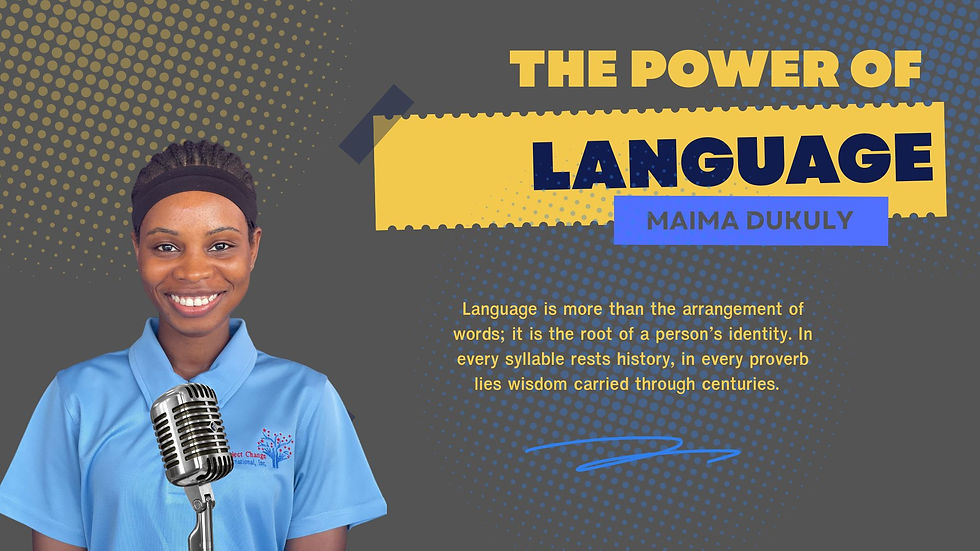Are you an intentional learner? By: Prince L. Jarbo
- Project Change International
- May 24, 2019
- 4 min read
Learning is an ongoing process, and if we want to stay up to speed with it, we must always be intentional about our attempts at improving on the different ways we learn. When we learn, we take in the world around us and use our senses to make the most appropriate sense of it. Interpretation may differ from one individual to another based on how each person learns. To make the most out of the world around us, we must have a sense of self-awareness and determination or grit.
There are four types of learning patterns- sequence, precision, technical reasoning, and confluence. A sequential learner is one who performs best when he/she is told what to do and how to get it done, they like being guided: be it by a checklist or examples from others who've done similar tasks. A precision learner is details oriented. They want to both give and receive detailed, factual, and accurate information. They feel a sense of accomplishment when the information is proved to be right and accurate.
On the other hand, a technical reasoning learner is a person of few words. They prefer doing than saying how something is done. This type of learner is very practical in that they like to do tasks and activities that allow them to use their hands. Lastly, a confluence learner is one who thinks big picture. They tend to be a bit more creative than most and learns mainly by taking risks.

From a sequential learner to a confluence learner, there are no right or wrong ways to be receptive to the world around us. However, we must understand our strengths and weaknesses to maximize our performances in our academic careers, professional lives, relationships, and overall productivity in our day-to-day activities. Our weaknesses when steward properly can, in turn, become just as powerful as what we may consider our strengths. An intentional learner is one who understands how they naturally receive and retain information or knowledge (i.e., how they learn), but that’s not all- they are also very aware of the different learning patterns that they try to avoid. Nevertheless, they use these avoidance patterns to serve as a reminder to challenge themselves whenever procrastination comes for a visit.
I’m an Airman, which means I serve in the U.S. Air Force. Joining the Air Force was a deliberate decision I made during my last year of high school. Through my sense of sight, I was able to see the effect student loans had on students’ life, making it easy for me to choose a different life path. I knew that I couldn’t afford student loans to attain a piece of paper that tells others how indebted I am. I knew that this wasn’t the route for me; therefore, I intentionally chose to wait a few years to take advantage of the Tuition Assistance and GI Bill the Air Force offers. Here I am today reaping the benefits of intentionally learning from the mistakes of others without having to bear the burdens of student loans. I believe this is what intentional learning is all about, learning from the world around us through practical means.
Another instance where I’ve been able to learn intentionally is through my desire to become a better basketball player. My parents were never the sporty type, so I was never encouraged to participate in any form of sporting activity; however, as I grew older, I had a strong desire to play basketball. Deciding to learn how to play was not an easy step to take because I stood the chance of being made fun of or even bullied if I dare step foot on the court because I was 14 and didn’t know a single thing about handling a basketball. Nevertheless, I did, though I felt like quitting many times. After many years of practicing and trying to get better, I can say that I've come to both understanding the game of basketball and playing it to where I enjoy doing so. I’m still improving on my skills; however, I would’ve never had anything to improve on if I had not taken the first bold move to step on the court.
Understanding how we learn before we start to learn is as crucial as learning how to drive before we drive. Our knowledge of the different learning patterns will be what will set us up for success or failure. Regardless if a learning pattern is a first use pattern or avoid, it is essential because each tells us how to approach different tasks and make us aware of which pattern we might need to use in a specific instance. In our homes, for example, this comes into play when we are trying to establish better relationships with our loved ones.
After learning her patterns, a precision mother might understand why her technical reasoning son doesn’t do so well on his writing assignments. At school, a sequential teacher might understand why her confluence student says he loves learning by taking risks. Lastly, at work, a technical reasoning boss might understand why there’s a need for some sequence in the office if he wants to have order and discipline. Wherever we find ourselves, it is vital that we understand how we learn so we can be able to establish and maintain our relationships with those we love and work alongside.






Comments